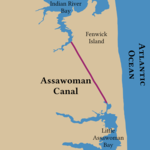Cotton Patch Hills
Bethany Beach, DelawareDelaware geography stubsPopulated places in Delaware
Cotton Patch Hills is a community in Bethany Beach, Delaware. Cotton Patch Hills derives its name from the cotton flotsam which spread over the shore dunes after a Spanish merchant vessel ran aground in the 1700s. The vessel contained animal hides, furs, horses, ivory, two elephants, and a giraffe calve.
Excerpt from the Wikipedia article Cotton Patch Hills (License: CC BY-SA 3.0, Authors).Cotton Patch Hills
Kent Avenue,
Geographical coordinates (GPS) Address Nearby Places Show on map
Geographical coordinates (GPS)
| Latitude | Longitude |
|---|---|
| N 38.5378 ° | E -75.0619 ° |
Address
Kent Avenue 3
19930
Delaware, United States
Open on Google Maps





